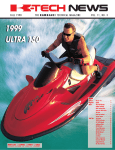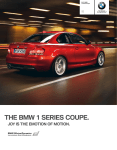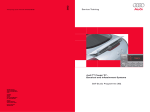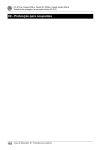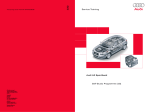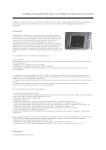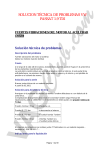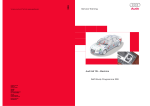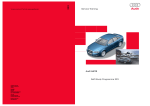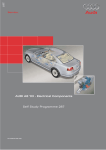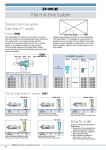Download Audi TT Coup'e '07 380 Specifications
Transcript
380 Vorsprung durch Technik www.audi.de Service Training Audi TT Coupé ‘07 Self-Study Programme 380 All rights reserved. Technical specifications subject to change without notice. Copyright AUDI AG I/VK-35 [email protected] Fax +49-841/89-36367 AUDI AG D-85045 Ingolstadt Technical status: 05/06 Printed in Germany A06.5S00.25.20 Self-study programmes on the TT Coupé Introduction SSP 380 Audi TT Coupé ‘07 The first generation of the Audi TT Coupé, named after the legendary "Tourist Trophy" race in the UK, was a milestone in automotive design. The design followed the pure geometry, with central motives being the circle, particularly distinctive on the wheel arches, the arches of the roofline, the front end and the rear end.Audi has taken this genetic code and developed it in authentic style. In the new TT, the geometric shapes merge fluidly with one another.The concave and convex arches radiate dynamism and movement while lending the TT Coupé the character of an athletic sculpture thrusting forwards. – – – – – – – Body Occupant protection Engine Suspension system Electrical system Air conditioning Infotainment Order number: A06.5S00.25.20 The front end of the new TT Coupé has gained in expressiveness and resoluteness, the most distinctive element being the singelframe radiator grille. Unlike the predecessor model, the rear end has a completely different outline to the front end. The rear lights create a three-dimensional effect by virtue of their visual depth. The trapezoidal cut-out around the license plate continues the flowing lines of the boot lid. The powerful exhaust tailpipes, wide diffusor and central rear fog light are borrowed straight from motorsport. SSP 381 Audi TT Coupé ‘07 Suspension System The dynamic impression conveyed by the Audi TT Coupé also stems from its modified proportions. – – – – On the exterior it is now: - 137 mm longer - 78 mm wider Front axle Rear axle Shock absorber system Brake system Order number: A06.5S00.26.20 SSP 382 Audi TT Coupé ‘07 Electrical and Infotainment Systems – – – – Networking Bus topology Convenience electronics Infotainment Order number: A06.5S00.27.20 SSP 383 Audi TT Coupé ‘07 - Body – – – – – – 380_043 Excellence in design & performance Audi Space Frame Production processes and joining methods Surface finish Electromechanical rear spoiler Repair concept Passive safety concept Order number: A06.5S00.28.20 Contents Introduction . . . . . . . . . . . . . . . . . . . . . . . . . . . . . . . . . . . . . . 4 Body . . . . . . . . . . . . . . . . . . . . . . . . . . . . . . . . . . . . . . . . . . . . 6 Occupant protection . . . . . . . . . . . . . . . . . . . . . . . . . . . . . . 8 Engine . . . . . . . . . . . . . . . . . . . . . . . . . . . . . . . . . . . . . . . . . . 22 Running gear. . . . . . . . . . . . . . . . . . . . . . . . . . . . . . . . . . . . 28 Electrical system . . . . . . . . . . . . . . . . . . . . . . . . . . . . . . . . . 38 Air conditioning . . . . . . . . . . . . . . . . . . . . . . . . . . . . . . . . . 42 Infotainment . . . . . . . . . . . . . . . . . . . . . . . . . . . . . . . . . . . . 50 The self-study programme teaches the design and function of new vehicle models, new automotive components or new technologies. The self-study programme is not a repair manual! All values given are intended as a guideline only, and refer to the software version valid at the time of publication of the SSP. For maintenance and repair work, always refer to the current technical literature. Reference Note Introduction Overview Dimensions of the Audi TT Coupé ‘07. 380_054 Audi TT Coupé ‘07 2.0l HS 2.0l s-tronic 3.2l HS qu 3.2l s-tronic qu Permissible gross weight in kg 1660 1680 1810 1830 Kerb weight without driver in kg 1260 1280 1410 1430 0.30 0.31 Drag coefficient Cw Fuel tank capacity in litres Body type Height of loading sill in mm Luggage compartment volume in l 4 0.30 55 60 Audi Space Frame (ASF) 790 290 (700l with rear-seat back folded forward) 380_040 Body / dimensions Length in mm 4178 + 137 Width in mm 1842 + 78 Height in mm 1352 +6 Wheelbase in mm 2468 + 46 Front track width in mm 1572 + 26 Rear track width in mm 1558 + 30 Number of seats 2+2 5 Body Audi Space Frame ASF of the Audi TT Coupé ´07 The development targets for the bodyshell of the Audi TT Coupé ‘07 With a weight advantage of 48 % over a comparable all-steel bodyshell, not to mention the optimised weight distribution, the new composite aluminium-steel spaceframe body of the TT Coupé marks yet another milestone in the development of modern Audi bodyshells. Crash safety of the bodyshell is enhanced by load-bearing structures at the front, sides and rear end with a heavy emphasis on pedestrian safety. To ensure efficient volume bodyshell production, various new joining and production techniques are employed. The repair concept is to a large extent based on the well-known aluminium repair concept, although combining the materials aluminium and steel meant, of course, that new approaches had to be taken. Sill section Audi TT Coupé ‘07 Four-chamber extruded section 380_062 Sill section Audi A8 Three-chamber extruded section 380_063 6 Technological concept Sheet-steel parts are used for the first time in the ASF of the Audi TT Coupé ‘07, in addition to aluminium castings, aluminium extruded sections and aluminium sheet-metal parts. Collectively they form the body structure. Vehicle weight distribution is optimised by using sheet-steel parts at the rear end of the body. This has a direct bearing on sporting characteristics such as driving dynamics and acceleration, as well as safety characteristics such as stopping distance and driving stability Despite the partial use of sheet-steel parts, the total body weight of 277 kg including attachments, such as doors and lids, is approx. 48 % less than that of a comparable full steel body. Although the TT Coupé has grown considerably in size, the overall weight of the vehicle has been reduced through the use of the aluminium steel bodyshell. The body structure of the Audi TT Coupé ‘07 has higher strength and 50 % higher torsional rigidity than its predecessor. Component parts overview 22 Aluminium castings 129 Sheet-aluminium parts 19 Extruded aluminium sections 107 Sheet-steel parts (galvanised) 380_061 Reference For details of design and function, refer to Self-Study Programme 383 Audi TT Coupé ‘07 - Body. 7 Occupant protection Occupant protection system in the Audi TT Coupé ‘07 The Audi TT Coupé ‘07 is a high-end sports car. However, the occupant protection system matches the vehicle's driving dynamics in every respect. Creating a sports car with a high occupant protection potential is always a big challenge. This challenge was met by the TT Coupé development team. The occupant protection system of the Audi TT Coupé ‘07 is composed of the following components and systems: – – – – – – – – – Airbag control unit Dual-stage driver and front passenger airbags Front side airbags Central crash sensor for front airbag, so-called "upfront" sensor for head-on collision detection Side impact detection sensors in the front doors Front belt tensioners Battery isolation igniter Belt switch, driver side Belt-on indicator Due to the different criteria and statutory requirements set by the various markets, the equipment specifications can vary. This applies particularly to the US market. Legend E24 Driver side belt switch E224 Front passenger side airbag deactivation key switch G179 Side airbag crash sensor, driver side G180 Side airbag crash sensor, front passenger side G283 Driver side front airbag crash sensor (central) 8 380_005 J234 J285 J393 J533 J623 Airbag control unit Control unit with display in dash panel insert Convenience system central control unit Data bus diagnostic interface (Gateway) Engine control unit K19 Seat belt warning system warning lamp K75 Airbag warning lamp K145 Front passenger side airbag deactivated warning lamp (PASSENGER AIRBAG OFF) N95 N250 N131 N132 N153 N154 N199 N200 N253 Airbag igniter, driver side Driver side airbag igniter -2Front passenger side airbag igniter 1 Front passenger side airbag igniter 2 Driver seat belt tensioner igniter -1Front passenger seat belt tensioner igniter -1Side airbag igniter, driver side Side airbag igniter, front passenger side Battery isolation igniter T16 16-pin connector, diagnosis connection 9 Occupant protection Airbag control unit J234 Airbag control unit J234 and integrated electronics have the task of detecting a collision. In the Audi TT Coupé ‘07 the airbag control unit is attached to the vehicle body in the area of the handbrake lever. The airbag control unit is integrated in the CAN powertrain data bus so that it can exchange information with other control units. The airbag electronics basically have the following main tasks: – Collision detection (front, side, rear) – Defined deployment of the belt tensioners, airbags and battery disconnect – Defined deployment of the second front airbag stage – Evaluation of all input information – Permanent monitoring of the complete airbag system – Independent energy supply via capacitor for a defined period of time (approx. 150 ms) – Fault display via failure warning lamp – Storage of error / and crash information – Indication of a collision event to other system components via the powertrain CAN bus or discrete collision output (conventionally wired) – Activate seat belt reminder 380_008 To find out which components need replacing after an accident, refer to the valid Workshop Manual in ElsaWin. An airbag control unit can only be replaced with a VAS tester running the "Guided Fault Finding" or "Guided Functions" application. Reference For more information about the airbag control unit J234, refer to SelfStudy Programmes 323 Audi A6 `05 and 361 Audi Q7. 10 Belt-on warning The Audi TT Coupé ‘07 has a belt-on warning function for the driver. The airbag control unit evaluates the information from the driver side belt switch E24 after ignition "on". If the driver is not wearing a seat belt, a visual warning is given by the seat belt warning system warning lamp K19 integrated in the dash panel insert.If the system determines that the vehicle is moving, an audio warning is given in addition to the visual warning.As long as the ignition is on, the airbag control unit monitors the switched condition of seat belt switch E24. If seat belt status changes while terminal 15 is "on", the seat belt reminder will be reactivated. Time diagram for seat belt reminder Visual and audio signals - Delayed seat belt fastening ON Terminal 15 OFF V > 25 kph Road speed v < 25 kph yes Seat belt fastened No ON Seat belt warning system warning lamp OFF ON Audio signal OFF Time 361_016 Driver side belt switch E24 The "belt-on warning" function needs information on whether the driver's seat belt is fastened or not. Seat belt switch E24 in the belt buckle is a mechanically actuated open-close switch. The airbag control unit uses a resistance measurement to establish whether the seat belt is fastened or not. 380_065 11 Occupant protection Airbag The Audi TT Coupé ‘07 has two-stage front airbags on the driver and front passenger sides. The airbag control unit selects the time interval between the two ignition stages (approx. 5 ms to 30 ms) according to severity and type of crash. The loads acting on the driver or front passenger during an accident can be reduced through time-staggered ignition of the propellant charges. Both propellant charges are always ignited. This ensures that no propellant charge remains active after the airbag is deployed. Driver airbag Airbag igniter I, driver side N95 Airbag igniter II, driver side N250 A gas generator with two pyrotechnic propellant charges is integrated in the driver's airbag. Igniter I is activated electrically by the airbag control unit J234. The igniter flame passes through the container and ignites the ignition charge in the container. If the pressure produced by the ignition of the ignition charge is high enough, the flame will break through the container and reach the propellant charge through the perforated tube. Propellant charge I ignites and combusts. The developing gas destroys the foil seal, and filtered gas flows through the air outlet into the airbag. After a defined interval has expired, the airbag control unit activates igniter II, which in turn ignites propellant charge II directly. The gas produced by combustion of the propellant material flows through the raised end cap into the combustion chamber of propellant charge I. From here the gas flows through the filter into the airbag. Perforated tube Ignition charge container Propellant charge II End cap Casing Foil seal Foil seal Air outlet Air outlet Filter Filter Igniter I Propellant charge I Igniter II 380_003 12 Front passenger airbag Airbag igniter 1, front passenger side N131 Airbag igniter 2, front passenger side N132 An airbag module with a two-stage hybrid gas generator is used in the Audi TT Coupé ‘07 on the front passenger side.This module is already in use in the Audi Q7. However, it has been adapted for the TT Coupé. Two pyrotechnic propellant charges integrated in a pressurised gas bottle are activated separately by the airbag control unit. The so-called cold gas in the pressurised gas bottle is under approx. 250 bar of pressure and is a mixture of approx. 98 % argon and approx. 2 % helium. Ignition charge I Propellant charge I Coil spring Filter Igniter I Igniter II Pressurised gas bottle Gas: approx. 98 % argon approx. 2 % helium Pressure: approx. 250 bar Ignition charge II Propellant charge II Coil spring Rupture disc 361_002 Reference For more information about the function of the front passenger front airbag, refer to Self-Study Programme 361 Audi Q7. 13 Occupant protection Side airbags Side airbag igniter, driver side N199 Side airbag igniter, front passenger side N200 Airbag modules which cover both the body and head areas - so-called head-thorax airbags - are used as side airbags. Tubular gas generators filled with solid propellant inflate the airbags with gas in the event of a crash. 380_004 The airbag control unit J234 energises the corresponding side airbag igniter. The ignition charge which is ignited by the igniter in turn ignites the actual propellant charge. The developing gas is treated and cooled by the metal filter, whereupon it unfolds and inflates the airbag. Ignition charge Detonator Metal filter Propellant charge Air outlet Air outlet 361_022 14 Driver seat belt tensioner igniter -1- N153 Front passenger seat belt tensioner igniter -1- N154 The Audi TT Coupé ‘07 is equipped with redesigned belt tensioners for the driver and front passenger. These belt tensioners are so-called "band tensioners". The TT Coupé for the North American market is also equipped with these belt tensioners. Seat belt Inertia-reel seatbelt If the rear seats in the TT Coupé are equipped with Isofix fixing eyelets, belt tensioners are also installed for these seats. Foil The workshop manual (ElsaWin) applicable to the vehicle describes the tests which must be made to detect an activated belt tensioner (band tensioner). An activated belt tensioner can be detected, among other things, by virtue of the fact that the foil located on the side of the belt tensioner housing is detached from the housing. Belt tensioner unit 380_030 A metal band is wrapped around the seat belt retractor shaft. Both open ends are connected to the seat belt retractor shaft. The closed end is looped around the belt tensioner igniter. Electrical connector Metal band Detonator Seat belt retractor shaft Metal band loop 380_027 15 Occupant protection The belt tensioner igniter is located inside the metal band loop. When the igniter is activated by the airbag control unit, the resultant pressure causes the loop of the metal band to expand.The movement of the metal band exerts a pull on the seat belt retractor shaft, which thereupon begins to rotate, tensioning the seat belt. Electrical connector Metal band Detonator Seat belt retractor shaft Metal band loop 380_028 The casing and casing cover surface between which the metal band moves are coated in a layer of silicon. When the metal band moves, it thrusts a part of this silicon layer ahead of itself and thereby ensures that a tight seal is maintained. Pressure losses are thus reduced. Casing Silicon layer Casing cover 16 Metal band 380_026 Battery isolation igniter N253 The battery isolation igniter has the task of disconnecting the starter and alternator leads from the vehicle battery in the event of a crash. Use is made of a pyrotechnic component which is activated by the airbag control unit J234 whenever the airbag is deployed. During a rear collision, only the belt tensioner and the battery isolation igniter are activated. Battery isolation igniter Pin Connecting element with terminals Detonator 332_030 If the pyrotechnic propellant charge is ignited, the resultant gas pressure displaces the pin on a piston and disconnects the two terminals. After deployment of the airbag, the battery isolation igniter must be replaced. 361_024 Reference Further information on the function of the battery isolation igniter, refer to Self-Study Programme 361 Audi Q7. 17 Occupant protection Additional functions and components of the occupant protection system for the North American market The additional functions and components of the occupant protection system for the North American market are described on the following pages. The occupant protection system is equipped with additional functions and components, e.g. second crash sensor for front airbag, so that the Audi TT Coupé ‘07 meets the statutory and marketspecific requirements for the US market. Seat occupied detection, front passenger side The front passenger side seat occupied recognition system was largely adopted from the Audi Q7. The system basically comprises the following components: – – – – Seat squab Sensor mat for seat occupied recognition Pressure sensor for seat occupied recognition G452 Seat occupied recognition control unit J706 These components form a single unit and must not be separated from each other. – Front passenger side belt switch E25 – Seat belt force sensor for seat occupied recognition G453 – Front passenger side airbag deactivated warning lamp K145 (PASSENGER AIRBAG OFF) – Airbag control unit J234 Driver side belt switch E24 Front passenger side belt switch E25 The Audi TT Coupé ‘07 for the North American market is equipped with seat belt switches for beltfastened recognition on the driver and front passenger sides. Seat belt switches E24 and E25 are integrated in the belt buckles on the front seats So-called "reed switches" are used. The reed switch remains open until the occupants have fastened their seat belts. The airbag control unit J234 performs a resistance measurement from which it can determine whether the occupants have fastened their seat belts or not. Depending on the position of the reed switch, the measurement is made using one or both resistors. 361_029 Reference For further information about the seat occupied recognition system and the seat belt switch, refer to SelfStudy Programme 361 Audi Q7. 18 Knee airbag igniter, driver side N295 Knee airbag igniter, front passenger side N296 The Audi TT Coupé ‘07 for the North American market is equipped with knee airbags for the driver and front passenger sides. Ignited knee airbags allow the occupants to participate earlier in the vehicle deceleration process. The airbag system of driver and front passenger front airbags in combination with knee airbags reduces the injury risk for the occupants. On the driver side, the knee airbag is located in the footwell trim panel below the dash panel.On the front passenger side, the knee airbag is located behind the glove box lid. After the airbags are activated, the airbag unfolds between the dash panel and the occupants' legs. View inside the dash panel Gas generator Airbag 380_006 Hybrid gas generators have the task of inflating the airbags with gas. The airbag control unit J234 activates the igniter in the gas generator. The resultant pulsation wave is directed to the rupture disc. The rupture disc breaks and the helium from the pressurised gas bottle flows into the airbag. Filter Air outlet Detonator 380_009 Filter Air outlet Rupture disc Pressurised gas bottle Gas: Helium Pressure: approx. 600 bar 19 Occupant protection Belt force limiter, driver side G551 Belt force limiter, front passenger side G552 The front inertia-reel seatbelts have a two-stage belt force limiter. In the event of a collision, the belt tensioners (band tensioners) are ignited first. The inertia-reel seatbelt blocks the seat belt retractor shaft and prevents the seat belt from unreeling, which would occur due to the forwards movement of the occupants. The seat belt retractor shaft is designed as a torsion shaft. To limit the load which the seat belt places on the occupants, two torsion shafts allow controlled unreeling of the seat belt; belt force limiter. After a defined interval, the airbag control unit activates the belt force limiter igniter. The second torsion shaft is decoupled. The seat belt retractor shaft now counteracts the force which the seat belt exerts. To ensure that the occupants are afforded a good level of protection, the belt tensioning function, the belt force limiting function and the front airbags are coordinated with each other. Gears I and II are permanently connected to the seat belt retractor shaft and the second torsion shaft respectively. In the initial state, both gears are in mesh with one another. Torsion shaft II Detonator Spline end Gear II Seat belt retractor shaft Gear I 380_013 Torsion shaft II Spline end Gear II Seat belt retractor shaft Gear I 380_012 20 The belt tensioner retracts the seat belt to the extent possible, and the inertia-reel seatbelt locks the seat belt retractor shaft. The seat belt can no longer be pulled out. If the occupant's body now accelerates forwards due to centrifugal force, the belt force limiter allows the seat belt to unreel as of a certain force.Both torsion shafts are rotated. Torsion shaft II Spline end Gear II Seat belt retractor shaft Gear I 380_011 Torsion shaft II Spline end Gear II After a defined period of time, the belt force limiter igniter is activated. The spline end decouples gear II from gear I. The belt force is now limited by the seat belt retractor shaft alone.The occupant can plunge into the fully inflated airbag. Seat belt retractor shaft Gear I 380_010 Detonator Torsion shaft II Spline end Gear II Seat belt retractor shaft Gear I 380_016 21 Engine Engine-gearbox combination 2.0l 4 cyl. TFSI MQ 350 6F / DQ 250 6F 380_045 380_060 380_042 3.2l VR6 MPI MQ 350 6A / DQ 250 6A 380_045 380_060 380_044 Reference For information about the design and function on the s-tronic, please refer to Self-Study Programme 386 6-speed Direct Shift Gearbox 02E. 22 2.0l TFSI The engine number is located at the rear left of the engine block in the area of the gearbox flange. Technical features – Toothed belt drive with CTC toothed belt sprocket – Selective petrol direct injection system (FSI) – Turbocharging – Pencil ignition coils – 1 primary catalytic converter and 1 main catalytic converter – 1 primary catalytic converter and 1 post-cat sensor 380_042 Torque/power curve Max. torque in Nm Max. power output in kW Engine speed in RPM 380_047 Specifications Engine code BWA Type of engine 4-cylinder petrol engine Displacement 1984 cm3 Power output 147 kW (200 bhp) at 5100 RPM Torque 280 Nm at 1800 - 5000 RPM Bore 82.5 mm Stroke 92.8 mm Compression ratio 10.5 : 1 Cylinder spacing 90 mm Weight approx. 152 kg Firing order 1–3–4–2 Engine management Bosch Motronic MED 9.1 Exhaust gas recirculation Internal exhaust gas recirculation Exhaust emission control 1 ceramic pre-catalytic converter with heating function via homogeneous split dual injection, 1 main catalytic converter Exhaust emission standard EU 4 / ULEV 23 Engine 3.2l VR6 MPI Technical features – – – – – Chain drive on the transmission side Cylinder-selective injection system Fully variable adjustment of both camshafts Pencil ignition coils 2 primary catalytic converters and 2 main catalytic converters 380_044 Torque/power curve Max. torque in Nm Max. power output in kW Engine speed in RPM 380_046 Specifications 24 Engine code BUB Type of engine VR6 petrol engine 15° vee angle Displacement 3,189 cm3 Power output 184 kW (250 bhp) at 6,300 RPM Torque 320 Nm from 2500 to 3000 RPM Bore 84.0 mm Stroke 95.9 mm Compression ratio 11.3 : 1 Offset 15° Firing order 1–5–3–6–2–4 Engine management Bosch ME 7.1.1 Camshaft adjustment range Intake camshaft 52° crank angle Exhaust camshaft 42° crank angle Exhaust gas recirculation Internal exhaust gas recirculation Exhaust emission control 2 primary catalytic converters and 2 main catalytic converters Exhaust emission standard EU 4 Fuel supply The fuel system is basically adopted from the A3 `04. The fuel tanks differ from one another in terms of their shape, which is dependent on the vehicle's drive concept. They are made of HPPE (high-pressure polyethylene). To safeguard the fuel tank against destruction in the event of an accident, it is mounted in front of the rear axle. Here it is fixed to the underbody by means of ratchet straps. It is not necessary to disassemble the rear axle to remove the fuel tank. The front tank has a capacity of 55 litres, the quattro tank 60 litres.The US spec quattro tank has a capacity of 55 litres, because a different breather system is used due to the different statutory requirements which apply. Front tank Breather pipe Fuel tank breather pipe Fuel delivery unit Fuel filter to tank Breather pipe 380_020 quattro tank Breather pipe Fuel tank breather pipe Suction jet pump (entrainment pump) + 2nd fuel tank sender Fuel delivery unit Fuel filter to tank Breather pipe 380_001 25 Engine Pressure regulation The fuel filter is bolted to the exterior of the fuel tank. The pressure regulator is integrated in the fuel filter. In case of excess pressure, the governed fuel is returned to the tank. The pressure regulator in the FSI engine cuts off fuel delivery at 6.4 bar (relative). In the case of the MPI engine, fuel cut-off is at 4 bar (relative). Both systems are returnless, with the distinction being that the pressure in the MPI engine is maintained at a constant 4 bar, while the FSI engine utilises a supply-on-demand fuel system. Reference Pressure regulation in the 3.2l and 2.0l engines is described in SelfStudy Programme 290 and Self-Study Programme 332 respectively. Fuel gauge sender For the MPI and FSI engines, a fuel delivery unit with integrated fuel gauge potentiometer and a suction jet pump are arranged inside the fuel tank. Suction jet pump Fuel pump 380_021 In the case of the quattro tank, a second fuel gauge potentiometer is arranged inside the second half of the fuel tank.The second half of the fuel tank also houses the suction jet pump, which pumps the fuel into the fuel delivery unit reservoir. The suction jet pump is attached securely to the sender flange by means of clips. The thin line is the propulsion jet line. It is driven by the suction jet pump. The thicker line is the mixing tube, in which the intake fuel is pumped to the fuel delivery unit. The fuel gauge senders are configured as slider potentiometers. Suction jet pump Fuel gauge sender 380_023 26 Fuel tank breather system, ROW spec (2.0l and 3.2l engines) Tank connection, fuel Tank connection, breather Activated charcoal canister Engine connection, fuel on 3.2l engine only 380_034 Fuel tank breather system, US spec (2.0l and 3.2l engines) Activated charcoal canister Tank connection, breather Fuel system diagnostic pump Engine connection, fuel on 3.2l engine only Tank connection, fuel 380_033 27 Engine Soundpipe A soundpipe is used on the 3.2l V6 engine to give the engine a sportier sound. The intake noise is transmitted to the vehicle body via a connecting line from the intake manifold to the plenum chamber and via a resonator. The soundpipe has been developed to accentuate the dynamism and sportiness of the 3.2l engine The soundpipe produces a sporty sound in the vehicle interior without impairing comfort. The pressure pulsations are amplified by the gas exchange cycle via the soundpipe without exceeding the exterior noise limits. Unwanted noise emission from ancillary units and tire noise are to a large extent avoided by the fact that the occupant cell is well-insulated. As a result, comfortable travelling is still possible. Secondary pipe Sound generator Primary pipe Air filter 380_014 28 Function A soundpipe is connected between the air mass meter and the throttle valve unit in the air intake tract. The soundpipe made up of three parts: the primary pipe, which is connected to the air intake tract, the sound generator and the secondary pipe, which is connected to the vehicle interior via the engine bulkhead. The primary and secondary pipes as well as the sound generator are configured in such a way that it is possible to influence the "bandpass characteristic"*, and hence the acoustic transmission range. However, the sound generator is the key component.The system is designed such that the sound becomes meatier when the driver demands more power from the engine. The pressure pulsations which during the gas exchange cycle are transmitted to the membranes in the sound generator, where they are amplified by the sound generator and relayed to the vehicle interior. Another further task the membranes is to seal the gas flow between the air intake tract and the vehicle interior. The foam core in the sound generator has the task of maintaining the shape and position of the membranes. * A bandpass characteristic is produced, for example, by connecting the highpass and lowpass filters in series. Only a defined range of frequencies is allowed to pass, depending on the circuit configuration. Sound generator Primary pipe Securing clip from intake manifold to vehicle interior 380_076 Secondary pipe Foam core Membranes O-ring 29 Suspension system Suspension system Overview The Audi TT Coupé ‘07 is available with three different suspension systems. The dynamic suspension system represents the basic specification. The semi-active "Audi magnetic ride" suspension is optional. The driver can select between comfort and sport suspension settings at the touch of a button. quattro GmbH is also offering an S-Line suspension system, which is sportier than the dynamic suspension system.The main axle components are identical to those of the Audi A3 in respect of their design and function. 380_074 Front axle An improved version of the McPherson suspension is used.The design of the front axle is identical to that of the Audi A3. Track width is 13 mm wider on each side than the Audi A3. Detail modifications have been made to reflect the particularly sporty character of the Audi TT Coupé ‘07. In addition to the tuning parts (springs, dampers and anti-roll bars), the same axle components are used in all TT Coupé suspension variants. 380_066 30 Rear axle The rear axle of the Audi TT Coupé ‘07 is basically identical in design and function to the rear axle on the Audi A3. The wheel carriers, damper bearings and wheel bearings are modifications on the components on the Audi A3.Track width has been increased by 15 mm on each side compared to the Audi A3. The suspension and damping components (springs, dampers and anti-roll bars) were adapted to the specific requirements of the TT Coupé. Additional stone chip protection is provided for certain markets. The trailing arms and spring links on these models are protected by plastic claddings. Rear axle for front-wheel drive 380_071 Rear axle for quattro models 380_072 31 Suspension system Brake system Overview ESP TEVES Mk60E1 with optional low tyre pressure indicator Front axle brake caliper 16" for all four-cylinder models 17" for all six-cylinder models Brake servo 10", 11", 7/8" with contactless brake light switch without dual rate characteristic 32 Rear axle brake caliper 16" for all four-cylinder models 17" for all six-cylinder models 380_073 33 Suspension system Steering system The electromechanical steering system EPS which has proved successful in the Audi A3 is also featured in the Audi TT Coupé ‘07. Various detail modifications have been made to adapt the steering system for use in the TT Coupé. 380_069 A mechanical steering column is fitted in the Audi TT Coupé ‘07. The steering column is basically identical in design and function to the steering column in the Audi A3. Various detail modifications have been made to adapt the steering column for use in the TT Coupé. 380_067 A redesigned steering wheel is used in the Audi TT Coupé ‘07. All models are fitted with threespoke leather-bound steering wheels with an integral two-stage airbag module. In addition to the standard version, combinations are also available of multifunction, Tiptronic and leather stitching in various colours. 380_068 34 Audi magnetic ride The Audi TT is the first Audi to feature Audi magnetic ride - a new semi-active suspension system with magneto-rheologically controlled dampers. A sport or comfort damper set-up can be activated at the touch of a button. Damper adjustment button E387 ECD control unit (electronically controlled damping) J250 Shock absorber damping adjustment warning lamp K189 Damper adjustment valve N336-339 Vehicle level sender G76-78, G289 380_064 Audi magnetic ride improves driving dynamics and driving comfort for the following reasons: – – – – reduced body movement (pitch and roll) optimised vibration behaviour improved road-holding improved handling Reference For details of the design and function of the suspension system, refer to Self-Study Programme 381 Audi TT Coupé ‘07 - Suspension System. 35 Suspension system Wheels and SST tyres (self supporting tires) Engine Basic wheels Optional wheels Winter wheels 4-cylinder 7.5J x 126 ET 45 (1) Cast aluminium wheel painted 225/55 R 16 8J x 17 ET 47 (3) Cast aluminium wheel painted 225/50 R 17 * 9J x 18 ET 52 (5) Cast aluminium wheel polished bi-color 245/40 R 18 * 7J x 16 ET 47 (7) Cast aluminium wheel painted 225/55 R 16 6-cylinder 8.5J x 17 ET 50 (2) Forged aluminium wheel painted 245/45 R 17 * 9J x 18 ET 52 (4) Cast aluminium wheel painted 245/40 R 18 * 8.5J x 17 ET 50 (6) Cast aluminium wheel painted 245/40 R 18 * 7J x 17 ET 47 (8) Forged aluminium wheel painted 225/50 R 17 * * also available optionally as SST wheel 9J x 18 ET 52 (9) Cast aluminium wheel painted 245/40 R 18 * 380_075 SST tyres have run-flat capability because of their modified design compared to conventional tyres. Much stiffer tyre sidewalls enable the vehicle to drive on for up to 50 km at a maximum speed of 80 kph even after a total loss of pressure. Special wheels are used for the SST tyres due to the modified tyre geometry. The special 17" wheels on the Audi TT Coupé ‘07 can be used both for conventional tyres and for SST tyres. In the case of the 18" wheels, conventional tyres are available in combination with conventional rims. SST tyres are always combined with the low tyre pressure indicator. 36 Low tyre pressure indicator In all markets except North America, the Audi TT Coupé ‘07 comes with an upgraded version of the low tyre pressure indicator previously featured in the Audi A3. Being an indirect measuring system, no tyre pressure sensors are installed in the wheels. Using a new evaluation method, it is now possible to detect simultaneous pressure loss to at multiple wheels. Tyre pressures are monitored simultaneously using two different concepts. 380_070 37 Electrical system Topology and networking Engine control unit J623 Direct shift gearbox mechatronics J743 Selector lever E313 ABS control unit J104 ECD control unit (electronically controlled damping) J250 Airbag control unit J234 Headlight range control, control unit J431 Four-wheel drive control unit J492 Tyre pressure monitor control unit 2 J793* Power steering control unit J500 Steering angle sender G85 Steering column electronics control unit J527 Multi-function steering wheel control unit J453 38 Power output module for left headlight J667 Power output module for right headlight J668 Diagnostic port Control unit with display in dash panel insert J285 Telephone transmitter and receiver unit R36 Data bus diagnostic interface J533 Driver door control unit J386 Digital satellite radio tuner R190 Front passenger door control unit J387 Digital sound package control unit J525 Parking aid control unit J446 TV tuner R78 Convertible top operation control unit J256 Radio R Auxiliary air heater control unit J604 Control unit with display for radio and navigation J503 Climatronic control unit J255 Anti-theft alarm system sensor G578 Convenience system central control unit J393 Alarm horn H12 Onboard power supply control unit J619 Wiper motor control unit J400 Tyre pressure monitor control unit J502** Rain and light detector sensor G397 CD changer R41 Powertrain CAN bus infotainment CAN bus Convenience CAN bus Dash panel insert CAN bus Diagnostics CAN bus LIN bus Subbus system Panasonic bus 382_044 * for tyre pressure monitoring system 2 only (ECE = Europe) ** for tyre pressure monitor only (SAE = North America) 39 Electrical system Installation overview - control units 40 382_067 Legend 1 2 3 4 5 6 7 8 9 10 11 12 13 Garage door operation control unit J530 Direct shift gearbox mechatronics J743 Power steering control unit J500 Engine control unit J623 ABS control unit J104 Wiper motor control unit J400 Alarm horn H12 Onboard power supply control unit J519 Headlight range control, control unit J431 Data bus diagnostic interface J533 CD changer R41 Tyre pressure monitor control unit 2 J793 / Tyre pressure monitor control unit J502* Control unit with display in dash panel insert J285 Radio R Control unit with display for radio and navigation J503 Climatronic control unit J255 14 15 16 17 18 19 20 21 22 23 24 25 Steering column electronics control unit J527 Steering angle sender G85 Multi-function steering wheel control unit J453 Rain and light detector sensor G397 Driver door control unit J386 Front passenger door control unit J387 Anti-theft alarm system sensor G578 Telephone transmitter and receiver unit R36 Airbag control unit J234 ECD control unit (electronically controlled damping) J250 Digital satellite radio tuner R190 Digital sound package control unit J525 Convenience system central control unit J393 Parking aid control unit J446 TV tuner R78 Radio controlled clock receiver J489 * for tyre pressure monitor only SAE 41 Air conditioning Overview The air conditioning system of the Audi TT Coupé ‘07 is an improved version of the system used in the Audi A3 ’04. The automatic air conditioning system is configured as a single-zone air conditioning system. The TT Coupé has only one climate zone with no temperature differential between the driver and front passenger sides. The TT Roadster is available with a heating-only system, in addition to the automatic air conditioning system. The TT vehicles with petrol engine have no auxiliary heater and, therefore, no electrical PTC heater element. The system has an air recirculation function, which can be activated either by the occupants or automatically as soon as the "on" conditions for air recirculation have been met. The automatic air recirculation function by means of an air quality sensor G238 was not implemented; no air quality sensor G238 is fitted. The fresh air intake duct temperature sensor G89 is not fitted. Information on ambient temperature is supplied only by the ambient temperature sensor G17 via CAN data bus from the dash panel insert. The Climatronic control unit J255 has a rotary knob for temperature selection, but no digital display. Air conditioner in Audi TT Coupé ‘07 Fresh air/ ram air flap Air recirculation flap Air flow flap control motor V71 Air recirculation flap control motor V113 Defroster flap Temperature flap control motor, right V159 Chest vent right Chest vent centre Defroster flap control motor V107 Chest vent left Temperature flap control motor, left V158 Central flap control motor V70 380_036 42 Climatronic control unit J255 The setpoint for the temperature flap is set using the "Temperature" rotary knob. The rotary knob is infinitely variable and activates the "Maximum cool" function in the lowest setting and the "Maximum heat" function in the highest setting. Automatic mode of the air conditioning system can be deactivated with the "Air flow" or "Air distribution" rotary knob or by pressing the DEFROST or AC key. The air conditioner compressor of the system can be switched on or off by pressing the AC key; the LED is on or off. The system is active without cooling function when the air conditioner compressor is off. DEFROST function key "Temperature" rotary knob "Air flow" rotary knob AUTO function key SEAT HEATER left function key REAR WINDOW DEFROSTER function key "Air distribution" rotary knob AIR RECIRCULATION function key SEAT HEATER right function key AC function key 380_049 The seat heater is optional equipment with the Audi TT Coupé ‘07. The three heater settings can be set by pressing the function keys. In setting 0 the seat heater is off; setting 0 cannot be selected directly from setting 3; it can only be activated by pressing the "Minus" key several times. The function keys are backlit and currently active functions are indicated by integrated LEDs. The control unit with display in dash panel insert J285 provides the dimming signals terminal 58d for the function LEDs and terminal 58s for the key backlighting via CAN bus. The LEDs of the function keys and the key backlighting cannot be switched individually. 43 Air conditioning Components of the air conditioning system in the Audi TT Coupé ‘07 Air conditioner compressor Single acting wobble plate compressor with 6 cylinders and variable delivery rate, without magnetic coupling, externally controlled. The air conditioner compressor is not a carry-over part from the Audi A3. The compressor stroke volume is regulated via the air conditioning system compressor regulating valve N280 by means of the PWM signal, depending on cooling power requirements. Air conditioning system compressor regulating valve N280 380_053 Ambient temperature sensor G17 Ambient temperature sensor (directly before the condenser) Only one ambient temperature sensor is used to evaluate the ambient temperature. The ambient temperature sensor G17 is located at the front end, on the right-hand side behind the bumper, directly in front of the condenser. Its value is provide by the control unit with display in dash panel insert J285 via CAN bus. If the ambient temperature sensor G17 is faulty, the ECON function is activated. This means that the active cooling function is deactivated and the AC LED goes out. 380_048 Dash panel temperature sensor G56 Dash panel temperature sensor The dash panel temperature sensor is integrated in the housing of the Climatronic control unit J255 and is ventilated by a suction blower. The temperature sensor can take on values from -50 °C to +77 °C. The dash panel temperature sensor is deactivated if the temperature sensor or ventilation motor is faulty. An entry is made in the data memory, and the Climatronic control unit J255 uses saved substitute values depending on the temperature set at the control panel. 380_052 44 Outlet temperature sensor For the driver side, one outlet temperature sensor is installed in the air duct of the chest vent and in the footwell duct. For the front passenger side, only the outlet temperature sensor is installed in the footwell duct. The Climatronic control unit J255 evaluates the outlet temperature sensor in dependence on the air distribution and determines from this the actual outlet temperature. If an outlet temperature sensor is found to be faulty, the temperature control is generally not deactivated. Depending on the operating mode (Heat or Cool) and the side of the vehicle on which the fault occurs (the front passenger side has only one outlet temperature sensor, in the footwell duct), the Climatronic control unit J255 decides whether the temperature control can remain active or has to be deactivated. If air distribution is in the DEFROST setting, the outlet temperature control is deactivated. Outlet temperature sensor 380_050 Combined filter in the Audi TT Coupé ‘07 A combined activated charcoal filter is standard on in the Audi TT Coupé ‘07. The combined filter is accessible from the front passenger footwell. The filter can be replaced without tools. The cover in the front passenger footwell is fixed in place with two wing bolts and the pollen filter air duct cover is located in position using a slide mechanism. The combined filter has two predetermined bending points.This makes the filter easy to bend and simplifies installation of the filter into the air conditioner. Dust and pollen filter Cover Fastening bolts Pollen filter air duct cover 380_051 45 Air conditioning Function diagram of the automatic air conditioning system G262 G263 G385* G386** G107 Signal, left 5V 12 V 12 V 12 V G261 Signal, right J255 V70 G112 V71 G113 V107 G135 Evaluation for driver's seat heating Evaluation for front passenger's seat heating Legend G56 Dash panel temperature sensor G65 High pressure sender G107 Sunlight penetration photo sensor G112 Central flap control motor potentiometer G113 Air flow flap control motor potentiometer G135 Defroster flap control motor potentiometer G143 Air recirculation flap control motor potentiometer G220 Left temperature flap control motor potentiometer G221 Right temperature flap control motor potentiometer G261 Vent temperature sender, left footwell G262 Vent temperature sender, right footwell G263 Evaporator out-flow temperature sender *G385 Front left chest vent temperature sender (left- hand-drive vehicles only) **G386Front right chest vent temperature sender (right-hand drive vehicles only) J126 Fresh air blower control unit J255 Climatronic control unit 46 Terminal 75 Terminal 30 Terminal 15 N280 G65 PWM J126 V2 PWM PWM V42 Diagnosis Convenience CAN data bus Terminal 31 G56 Dash panel temperature sensor Positive 5 V Earth V113 G143 V158 G220 V159 G221 Termin 380_037 N280 Air conditioning system compressor regulating valve Input signal for J255 Output signal from J255 V2 V42 V70 V71 V107 V113 V158 V159 Fresh air blower Temperature sensor blower Central flap control motor Air flow flap control motor Defroster flap control motor Air recirculation flap control motor Temperature flap control motor, left Temperature flap control motor, right Positive 5 V / 12 V Terminal 13 / earth CAN data bus 47 Infotainment Radio navigation systems at a glance Audi Navigation (BNS 5.0) General Audi Navigation plus (RNS-E) 6 inch dot matrix display, monochrome 6.5 inch TFT colour display Light dimming via CAN bus Display in driver information system MMI operating logic can be operated via optional multifunction steering wheel 6 function keys 8 function keys (incl. Name, Car) CD drive for navigation CD, audio CD or MP3 CD DVD drive for navigation DVD or audio CD or MP3 CD 9 languages German, English, French, Italian, Dutch, Portuguese, Swedish, Spanish and Czech can be loaded via CD 6 languages (German, English, French, Italian, Spanish, Portuguese) Clock in status bar 2-DIN housing Integrated 2 x 20 W power module, Audi sound system with auxiliary amplifier as standard Mute function via Power button (hierarchical mute function) --- Version display via CAR menu --- Optional voice recognition system for radio, CD, navigation and telephone Radio 2-tuner FM/MW/LW with TMC Dynamically updated station list Diversity aerials --- CD/MP3 TP Memo function Navigation CD drive reads audio CDs and MP3 CDs 6-CD autochanger or iPOD connectivity 48 --- 2 integrated MMC/SD card slots for MP3 files --- MP3 playlist support Table cont'd Audi Navigation (BNS 5.0) Navigation CD navigation system incl. Major Roads of Europe Audi Navigation plus (RNS-E) DVD navigation system, single-DVD drive Dynamic navigation system with RDS and TMC Turning instructions and directional arrow display in driver information system Telephone Destination input options: postcode, place name, street name, POIs, latitude and longitude Destination input options: postcode, place name, street name, POIs, cursor, address book Shortest/optimum/quickest route are selectable max. 3 route options are given max. 6 intermediate destinations are possible max. 3 intermediate destinations are possible --- Colour screen incl. Birdview, split screen and POIs --- Geometric motorway exit display --- Intersections map --- List display of the next three route recommendations --- Intelligent Speller (last city history) Corridor function allows audio or MP3 CDs to be played while navigating --- Mute function for hands-free telephone via cable or CAN Loudspeaker control unit for hands-free telephone, adjustable volume control unit for calls Telephone (with optional Audi mobile phone adaptor) Display of reception level, network provider and roaming symbol "accept call", "reject call" and "hang up" functions Telephone number entry via Speller Telephone number selection from the mobile phone phonebook Bluetooth symbol appears in the status bar if the mobile phone is connected to the mobile phone adaptor via Bluetooth. Voice control functions of mobile phone adaptor active Voice control system integrated in mobile phone adaptor or voice recognition system --- Telephone number selection from the address book Options BOSE sound system Mobile phone adaptor --- Analog TV tuner No auxiliary input (AUX-In) Service All amplifiers can be encoded for GALA, while BOSE Sound amplifiers are encoded as standard for Audio-Pilot Audi Sound System has GALA while the BOSE Sound System has Audio Pilot Vehicle-specific sound curves can be encoded Diagnostics via CAN (A3, TT) or L-wire (A4) 4-digit radio code incl. convenience code Transport mode via CAN Transport mode via adaption channel or CAN System software is flashable by CD in service workshops System software is flashable by navigation DVD 49 Infotainment Radio systems at a glance chorus concert symphony 2-DIN housing Three-line graphic display, light dimming via CAN can be operated via optional multifunction steering wheel Station frequency display in the driver information system FM/AM tuner FM tuner with phase diversity RDS (Radio Data System) with EON (Enhanced Other Network) --- --- Traffic Information Messages (TIM = TP Memo) Integrated single-CD drive, CD text capable Integrated single-CD drive for audio CDs and MP3 CDs, CD text capable Integrated 6-disc CD changer for audio CDs and MP3 CDs, CD text capable Control unit for external 6-disc CD changer or auxiliary iPod adaptor AUX input (code-activatable) Mute function for hands-free telephone Loudspeaker control unit for hands-free telephone Diagnostics via CAN (A3 8P, TT) or L-wire (A4 8E) Transport mode (reduced power demand) Anti-theft device with convenience coding Integrated 2 x 20 watts power module (not used for concert and symphony radios in the Audi TT) --- Auxiliary sound amplifier connected --- Connectivity for optional auxiliary BOSE Surround Sound amplifier Volume adjustment as a function of road speed (GALA) Basic sound set-up via encoding of vehicle type (saloon/Avant/Cabrio), interior trim (fabric/leather) and engine type (petrol/diesel engine) US variant RDBS FM/AM radio (FM/MW) Control unit for optional digital satellite tuner Reference For detailed descriptions of radios and navigation systems, refer to Self-Study Programme 382 Audi TT Coupé ‘07 - Electrical and Infotainment Systems 50 Self-study programmes on the TT Coupé Introduction SSP 380 Audi TT Coupé ‘07 The first generation of the Audi TT Coupé, named after the legendary "Tourist Trophy" race in the UK, was a milestone in automotive design. The design followed the pure geometry, with central motives being the circle, particularly distinctive on the wheel arches, the arches of the roofline, the front end and the rear end.Audi has taken this genetic code and developed it in authentic style. In the new TT, the geometric shapes merge fluidly with one another.The concave and convex arches radiate dynamism and movement while lending the TT Coupé the character of an athletic sculpture thrusting forwards. – – – – – – – Body Occupant protection Engine Suspension system Electrical system Air conditioning Infotainment Order number: A06.5S00.25.20 The front end of the new TT Coupé has gained in expressiveness and resoluteness, the most distinctive element being the singelframe radiator grille. Unlike the predecessor model, the rear end has a completely different outline to the front end. The rear lights create a three-dimensional effect by virtue of their visual depth. The trapezoidal cut-out around the license plate continues the flowing lines of the boot lid. The powerful exhaust tailpipes, wide diffusor and central rear fog light are borrowed straight from motorsport. SSP 381 Audi TT Coupé ‘07 Suspension System The dynamic impression conveyed by the Audi TT Coupé also stems from its modified proportions. – – – – On the exterior it is now: - 137 mm longer - 78 mm wider Front axle Rear axle Shock absorber system Brake system Order number: A06.5S00.26.20 SSP 382 Audi TT Coupé ‘07 Electrical and Infotainment Systems – – – – Networking Bus topology Convenience electronics Infotainment Order number: A06.5S00.27.20 SSP 383 Audi TT Coupé ‘07 - Body – – – – – – 380_043 Excellence in design & performance Audi Space Frame Production processes and joining methods Surface finish Electromechanical rear spoiler Repair concept Passive safety concept Order number: A06.5S00.28.20 380 Vorsprung durch Technik www.audi.de Service Training Audi TT Coupé ‘07 Self-Study Programme 380 All rights reserved. Technical specifications subject to change without notice. Copyright AUDI AG I/VK-35 [email protected] Fax +49-841/89-36367 AUDI AG D-85045 Ingolstadt Technical status: 05/06 Printed in Germany A06.5S00.25.20




















































